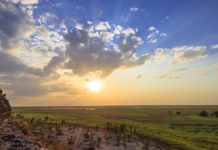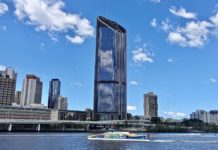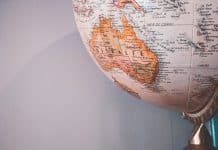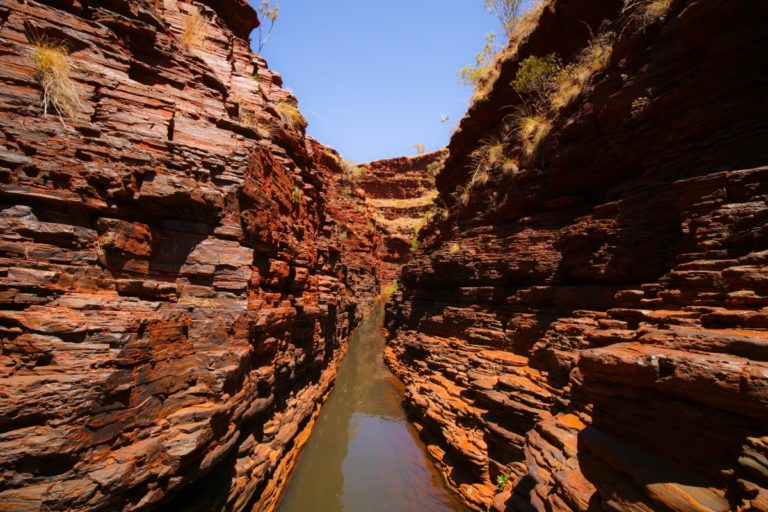
Karijini National Park, located in the Pilbara region of Western Australia, is one of the country’s most stunning natural landscapes. If you are planning a road trip on the west coast of the country or in the North, be sure to venture there. Known for its breathtaking gorges, crystal-clear rock pools, and diverse flora and fauna, Karijini offers visitors an unforgettable experience of Australia’s rugged beauty. This complete guide will provide you with all the information you need to make the most of your visit to Karijini National Park.
Table of Contents
General information about Karijini National Park
Karijini is located in the Hamersley Range and is the second largest park in Western Australia with an area of 6274 km². The park is located in north-western Australia, more than 1000 km from the capital, Perth.
Far from mass tourism, because it is isolated from the big cities, the park offers spectacular natural landscapes. The vegetation is lush, despite the region’s drought. In winter, many colourful flowers appear. Swimming and hiking in the gorges mingle and the discovery of a varied fauna.
Karijini is home to a diverse range of wildlife, including kangaroos, rock wallabies, dingoes, and various bird species. Early mornings and late afternoons are the best times for wildlife spotting.
The reliefs of this region are more than 2,500 million years old. There are three Aboriginal tribes: Banyjima, Kurrama and Innawonga.
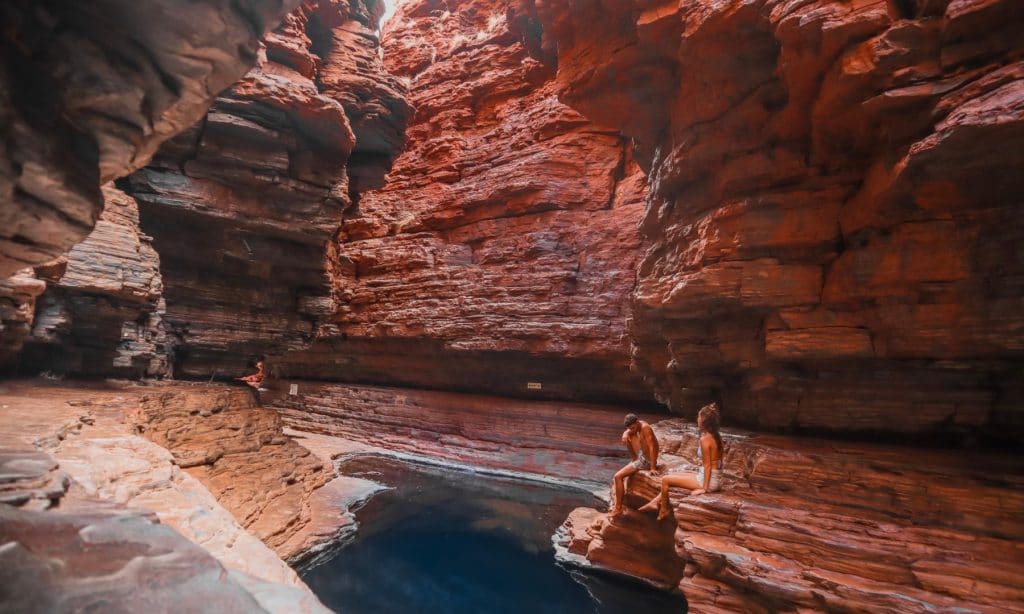
The park has two paid entrances, one to the east and the other to the west. The entrance fee to the park is $17 per vehicle per day. If you sleep there, you will only pay for the first day.
Getting to Karijini National Park
If you are coming from the west coast
Karijini National Park is accessible by car, with the nearest major towns being Tom Price (about 80 km away) and Newman (about 140 km away). The park is approximately 1,400 km north of Perth, making it a two-day drive for those traveling from the city. The roads to the park are generally in good condition, but some sections are unsealed, so a 4WD vehicle is recommended.
If you are coming from the North
From the North, 300 km separate Karijini from Port Hedland. By this way, you will not need to cross the park to make your last purchases. A complex located 36 km north of the eastern entrance offers a campsite. A site with (or without electricity depending on your budget), showers, toilets and a kitchen area, as well as a gas station. They even have a small convenience store. However, the prices are quite high.
In addition, the spots and hikes offered by Karijini are mainly located in two spots. One in the West and the other in the East. The main road is paved but a few that lead to spots are not.
By Air
The closest airports are in Paraburdoo and Newman, with flights available from Perth. From there, you can rent a car and drive to the park. Paraburdoo Airport is about 100 km from Tom Price, making it a convenient option for travelers.
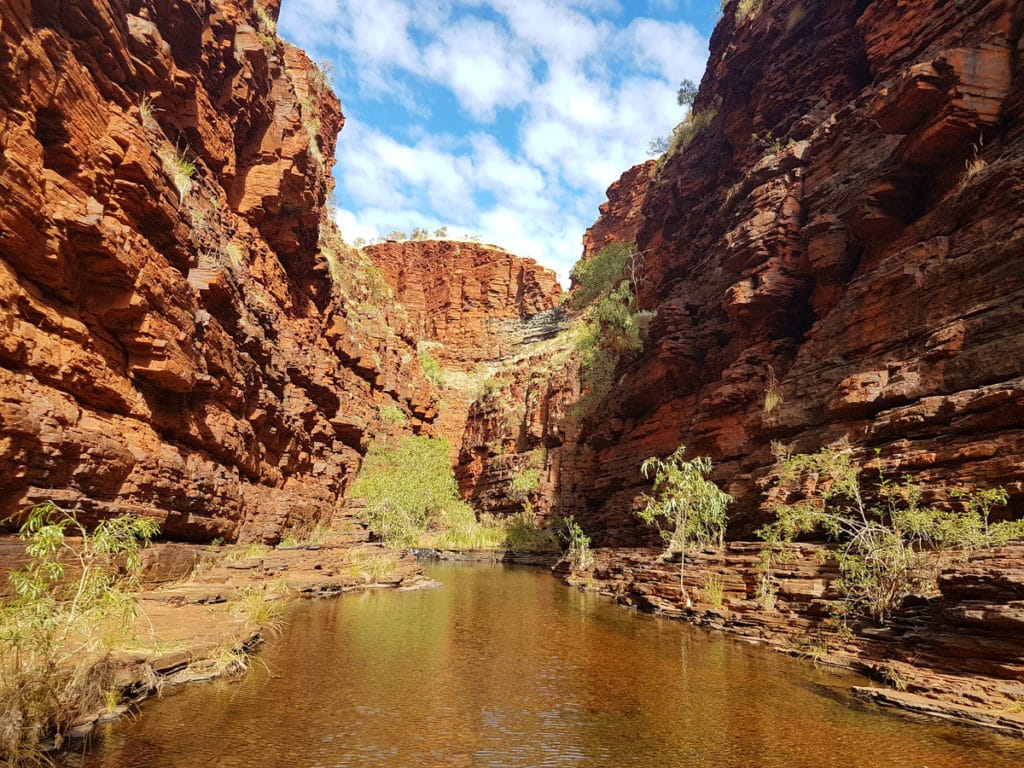
Best time to visit Karijini
The park is open year-round but can occasionally be closed due to climatic conditions (closed roads due to floods, cyclones, etc.).
It enjoys a tropical semi-arid climate. During the day it is warm and sunny in winter (March – October), while in summer (November – February) it is very hot day and night. At times it gets very humid with heavy rains, thunderstorms, and the possibility of cyclones.
Avoid Karijini during the wet season from November to January. Any other time, the weather is nice. July is the coolest month. The weather is best from May to September, but this is also the most touristy season.
To have enough time to do a few of the hikes in Karijini, you should plan at least 3 days on site. Depending on the weather and your vehicle, 2 days might be enough.
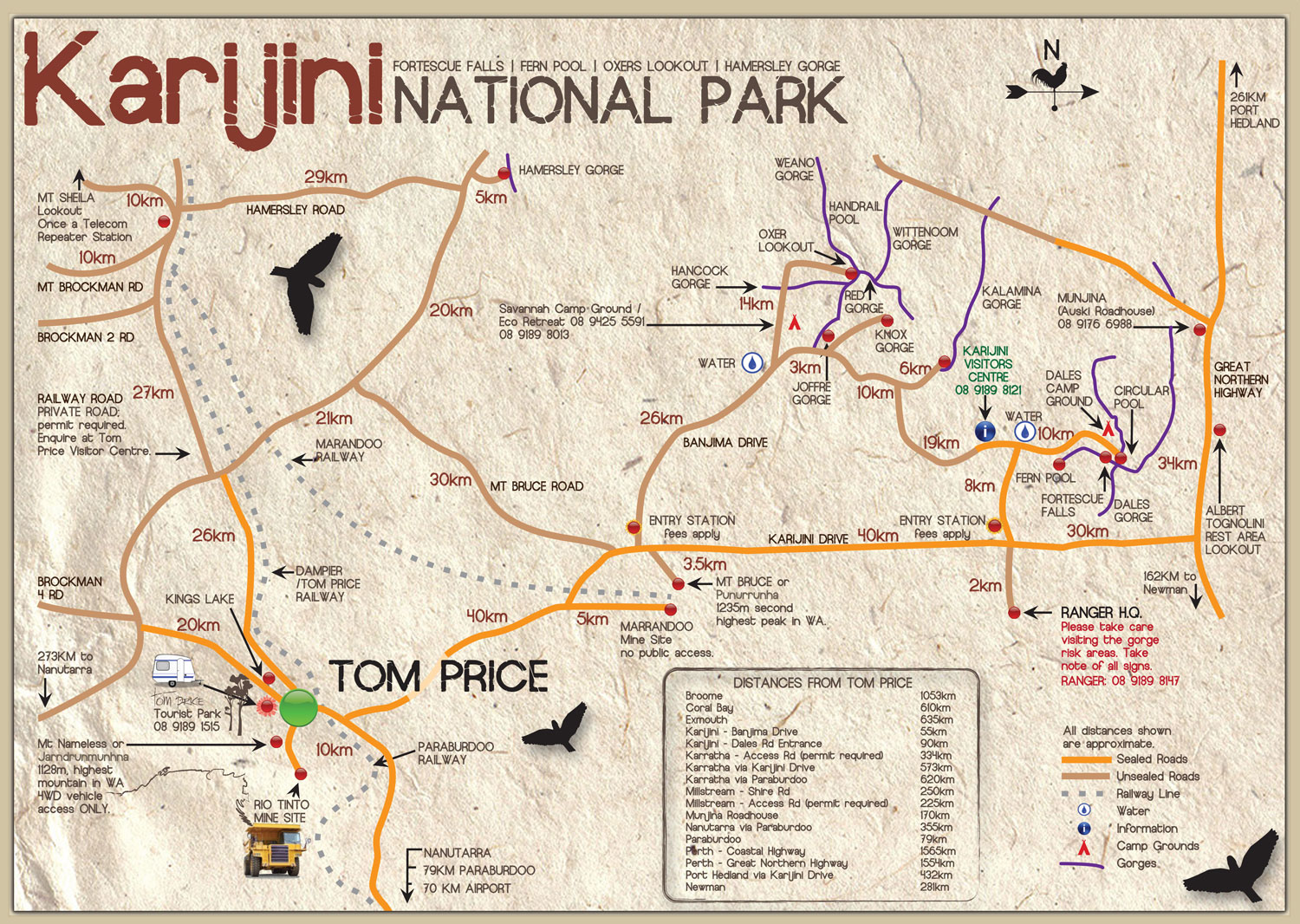
Best spots and hikes at Karijini National Park
Hancock Gorge
The “Hancock Gorge”, also called Spider Walk, is an atypical hike through canyons. Some parts of the trail require acrobatic talent: you have to climb the rocks of the gorge to get to a beautiful emerald-green pool, the Kermits pool.
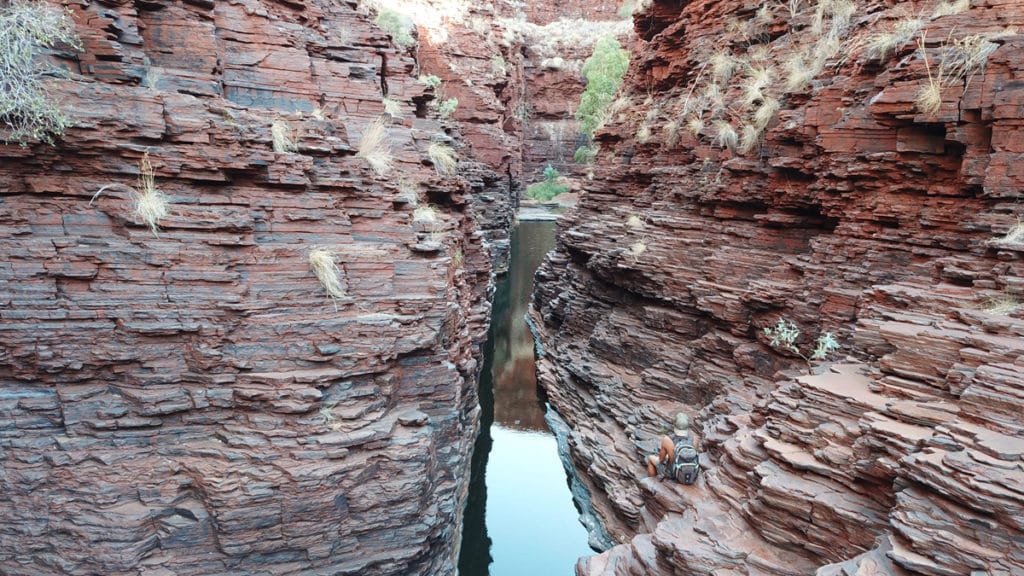
Fortescue Falls
A short walk will take you to this big blue pond and waterfalls. A beautiful waterfall that cascades into a natural swimming pool, perfect for a refreshing dip.
Fern Pool
A 10-minute walk from Fortescue falls, this natural pool surrounded by thick vegetation is a call to relax. You will see various varieties of birds, and maybe even bats and monitor lizards. A serene swimming spot surrounded by lush greenery.
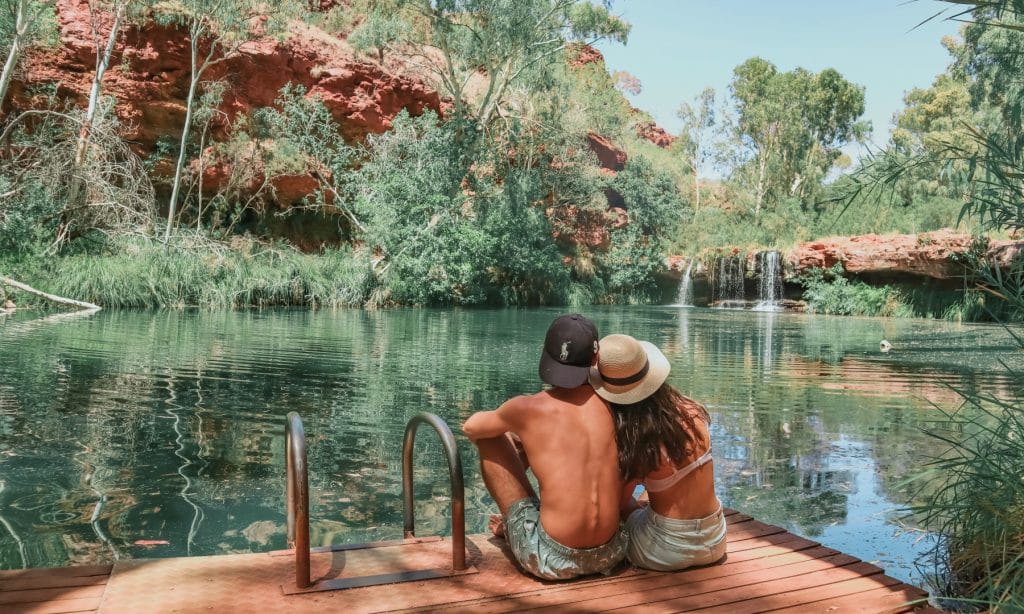
Handrail Pool and Weano Gorge
Weano Gorge is famous for its dramatic scenery and challenging hikes. When you get to the bottom of the gorge, you walk through a landscape of red rocks. Depending on the season, you pass by several pools and particularly the large Handrail Pool.
Oxer Lookout & Junction Pool
This gorgeous view is worth a visit! You look at huge gorges and a natural pool, which can be virtually empty depending on the season.
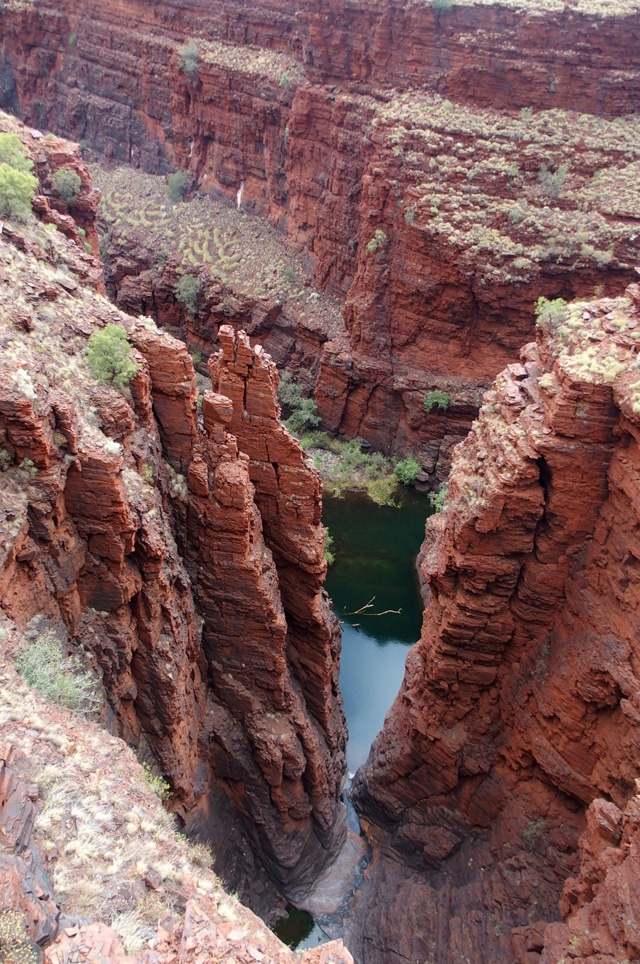
Mount Bruce
Mount Bruce or Punurrunha (name of the indigenous people) is the second highest mountain in Western Australia, with a height of 1,235 meters. It is located in Karijini National Park, just a few miles from the main road that runs through the park from east to west.
The 9km hike (up and down the mountain) is challenging but worth the trip. It takes about 5 hours.
The first part is pretty easy and not steep. On the right, you see the working Marandoo Iron Mine. On the left side, you see the red soil and dense vegetation of the hilly landscape.
The second part of the hike is more difficult due to the considerable incline. In some places you have to climb rocks. The steepest passage has a rope to hold on to. Once at the top, enjoy your reward: a 360-degree view of the surroundings!
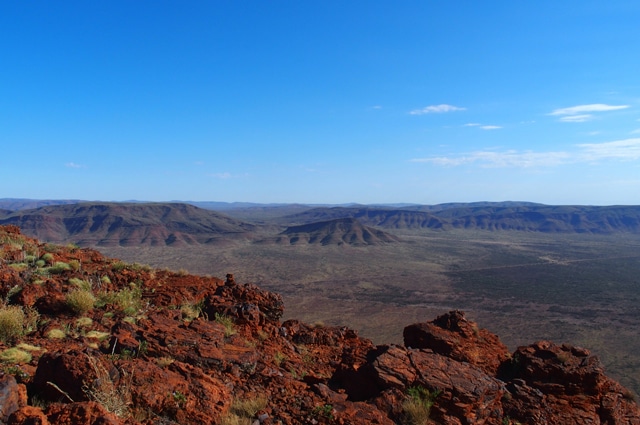
💡 Tips for hiking Mount Bruce
At very high temperatures, it is strongly recommended to hike at sunrise (5-6 o’clock depending on the season). At this time of day, you are in the shade for most part of the hike and you can watch the sunrise behind the mountain. Take a lot of water and food. There is no water holes along the way. Of course, wear good hiking boots. If you want to enjoy this beautiful hike in the best possible way, wear a fly net!
What to do in 2 days in Karijini National Park?
If the Karijini National Park is a simple stage in your road trip, we advise you to stay at least 2 days and 1 night in the park.
So as not to miss any of the best hikes and the most beautiful gorges, we have listed the unmissable ones for you.
Day 1, West part of the park
- Hancock Gorge to Kermits Pool
- Joffre-Gorge
- Spider Walk
- Weno Gorge to Handrail Pool
Day 2, East part of the park
- Fortescue Falls & Fern Pool
- Circular Pool.
Accommodation guide in Karijini National Park
In the park there are two campsites on the east side next to Circular Pool, Dales Gorge, Fern Pool, and Fortescue Falls. The main campsite is Dales Campground Karijini. There are large sites, dry toilets (handicapped disability-friendly), shade, and picnic tables. The second campsite “Dales Gorge Overflow Camping” is only open if the first one is full. This is a transition campsite where you can stay for 24 hours only. Camping in the park costs 15 AUD per night. You leave cash in a designated box at the entrance of the campsite.
On the west side of the park, you can stay at the Karijini Eco Retreat, if your budget allows it. This campsite has toilets, showers, drinking water, shade, tables, garbage bins, barbecues and a kitchenette. There’s something for everyone, from a simple, unpowered site for 20 AUD per person to a deluxe Glamping tent for over 300 AUD per night. You can find all the information on this website and book online at www.karijiniecoretreat.com.au
If you don’t want to pay for a campsite in the park, you will surely find a free spot on the side of the road near the two entrances. These locations are listed on the Wikicamp app (AUD 8).
Practical Information
Entrance Fees
Visitor Centre
To the west of the park, in the town of Tom Price, there is another visitor center, which also has the same quality of services and information.
To not miss anything during your visit, we advise you to stop there!
Park Map as PDF
Rent a campervan or 4x4
Climate
In bad weather, there can be heavy rains, thunderstorms or cyclones in Karijini. Check the weather forecast before embarking on your adventure.
Drinking Water in the Park
Stay Hydrated: Carry plenty of water, especially during hikes.
Tips for the Trip
Sturdy, non-slip shoes are essential for navigating the rocky terrain.
For your safety, stick to marked trails and be aware of your surroundings.
Get enough petrol for the park, and a little more to be safe. It is best to refill one or two jerrycans in a big city before hitting the road.
The roads are sometimes very bad and almost impossible to cross without 4×4, depending on the weather conditions. Inform yourself about the condition of the roads before you go.
There is practically no mobile network in the park. Get a hiking map and various brochures at the visitors centre.
Enjoy and respect the beauty of Karijini and take your rubbish with you.




















